大学英语语法之动词简介 Introduction to Verbs
英语动词的用法归纳总结
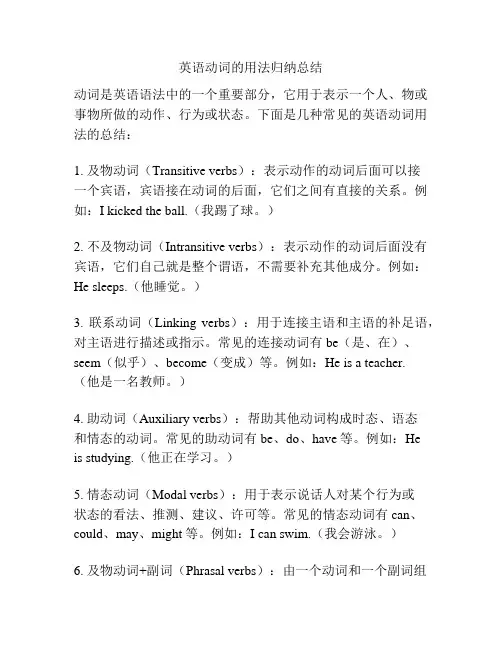
英语动词的用法归纳总结动词是英语语法中的一个重要部分,它用于表示一个人、物或事物所做的动作、行为或状态。
下面是几种常见的英语动词用法的总结:1. 及物动词(Transitive verbs):表示动作的动词后面可以接一个宾语,宾语接在动词的后面,它们之间有直接的关系。
例如:I kicked the ball.(我踢了球。
)2. 不及物动词(Intransitive verbs):表示动作的动词后面没有宾语,它们自己就是整个谓语,不需要补充其他成分。
例如:He sleeps.(他睡觉。
)3. 联系动词(Linking verbs):用于连接主语和主语的补足语,对主语进行描述或指示。
常见的连接动词有be(是、在)、seem(似乎)、become(变成)等。
例如:He is a teacher.(他是一名教师。
)4. 助动词(Auxiliary verbs):帮助其他动词构成时态、语态和情态的动词。
常见的助动词有be、do、have等。
例如:Heis studying.(他正在学习。
)5. 情态动词(Modal verbs):用于表示说话人对某个行为或状态的看法、推测、建议、许可等。
常见的情态动词有can、could、may、might等。
例如:I can swim.(我会游泳。
)6. 及物动词+副词(Phrasal verbs):由一个动词和一个副词组成的短语,表示特定的意义。
例如:She turned up the volume.(她调高了音量。
)7. 不及物动词+介词(Prepositional verbs):由一个动词和一个介词组成的短语,表示特定的意义。
例如:He insisted on going.(他坚持要去。
)8. 及物动词+宾补(Transitive verbs with object complements):动词之后有一个宾语和一个宾补,它对宾语进行进一步的描述或说明。
例如:They named the baby John.(他们给宝宝起名叫约翰。
大学英语动词介绍an Introduction to the Verb
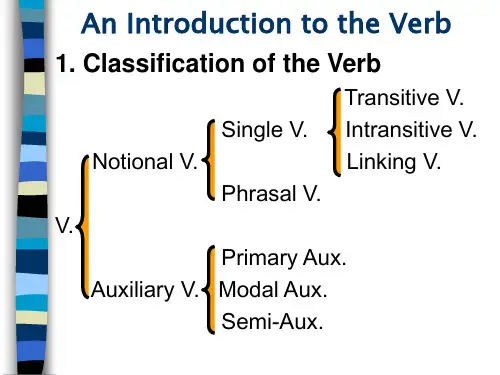
1.2 Single V. & Phrasal V.
He caught a fish.
The first World War broke out in 1914.
Single V.: one-word verb; Phrasal V.: A verb that consists of two
or more words.
1.3.4 Linking Verbs (link v. + predicative/compliment) A. be B. keep, remain, stay, rest
C. appear, seem, look, smellet, go, turn, grow, run, fall,
1.3 Transit. V.; Intransit. V.; Linking V.
1.3.1 Transitive Verb a. single-object Vt. He caught a fish. b. double-object Vt. Father bought me a camera. I want to ask you a few questions. c. complex-object Vt. We elected him chairman of the committee. O. C. I found the novel very interesting. O. C.
1.3.3 Verbs of bi-identity ( vt.& vi.) eg. The bell rings. The waiter rings the bell.
They grow coffee in Brazil. Coffee grows in Brazil. They beat him unconscious. Her heart was beating violently.
大学英语语法总结(全面)
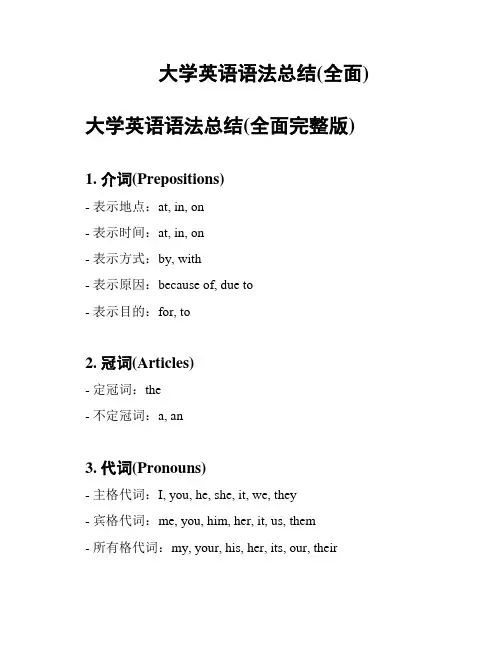
大学英语语法总结(全面)大学英语语法总结(全面完整版)1. 介词(Prepositions)- 表示地点:at, in, on- 表示时间:at, in, on- 表示方式:by, with- 表示原因:because of, due to- 表示目的:for, to2. 冠词(Articles)- 定冠词:the- 不定冠词:a, an3. 代词(Pronouns)- 主格代词:I, you, he, she, it, we, they- 宾格代词:me, you, him, her, it, us, them- 所有格代词:my, your, his, her, its, our, their- 反身代词:myself, yourself, himself, herself, itself, ourselves, themselves4. 名词(Nouns)- 单数名词:book, chair, dog- 复数名词:books, chairs, dogs- 不可数名词:water, money, information5. 动词(Verbs)- 一般现在时:I walk, you walk, he/she/it walks, we walk, they walk- 一般过去时:I walked, you walked, he/she/it walked, we walked, they walked- 现在进行时:I am walking, you are walking, he/she/it is walking, we are walking, they are walking- 过去进行时:I was walking, you were walking, he/she/it was walking, we were walking, they were walking- 一般将来时:I will walk, you will walk, he/she/it will walk, we will walk, they will walk6. 形容词(Adjectives)- 描述名词特征:big, small, tall- 比较级:bigger, smaller, taller- 最高级:biggest, smallest, tallest7. 副词(Adverbs)- 表示方式:quickly, slowly- 表示程度:very, extremely- 表示时间:now, yesterday8. 连词(Conjunctions)- 表并列:and, or- 表递进:furthermore, moreover- 表转折:however, but- 表原因:because, since以上是大学英语语法的简要总结,希望对你有帮助。
英语语法讲解Verbs
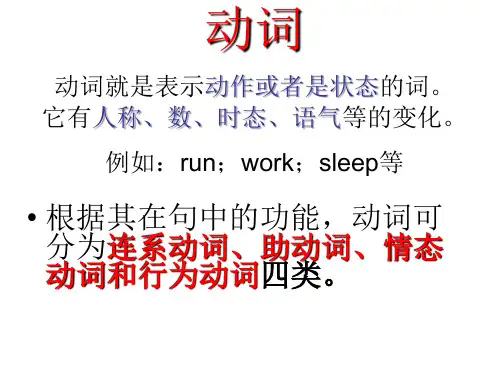
• work ---- working
sleep ----- sleeping
study ----- studying
• 2. 以不发音的-e结尾,要去-e加-ing
• take ----- taking
make ----- making
dance ----- dancing
• 3. 以一个辅音字母结尾的重读闭音节动词,要双写词尾辅音字母,再加-ing
• 4.以辅音字母结尾的重读闭音节,双写最后一个辅音字母再加ed,如stop——stopped
• go • do/does • sit • give • teach • buy
不规则变化
went did sat gave taught bought
动词现在分词形式变化规则
• 1. 一般情况下,直接在动词后加-ing
1)be动词:am is are was were 2)感官动词:look sound smell
taste feel seem 3)转变性动词:get become
②助动词
最常用的助动词有:be, have, has, had, do, does, did
• 1) 助动词自身没有词义,不可单独使用 • 2) 助动词协助主要动词完成以下功用, • a. 表示时态 • He is working. • b. 表示语态 • He was sent to England. • c. 构成疑问句 • Do you like bananas? • d. 与否定词not合用,构成否定句 • I don't like him.
动词有五种形式
• 分别是:原形、第三人称单数、过去式、 现在分词、过去分词。
动词三单形式变化规则
英语中动词的讲解
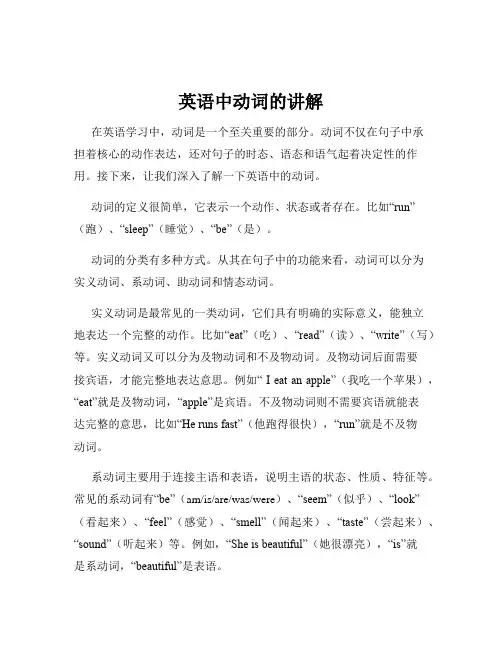
英语中动词的讲解在英语学习中,动词是一个至关重要的部分。
动词不仅在句子中承担着核心的动作表达,还对句子的时态、语态和语气起着决定性的作用。
接下来,让我们深入了解一下英语中的动词。
动词的定义很简单,它表示一个动作、状态或者存在。
比如“run”(跑)、“sleep”(睡觉)、“be”(是)。
动词的分类有多种方式。
从其在句子中的功能来看,动词可以分为实义动词、系动词、助动词和情态动词。
实义动词是最常见的一类动词,它们具有明确的实际意义,能独立地表达一个完整的动作。
比如“eat”(吃)、“read”(读)、“write”(写)等。
实义动词又可以分为及物动词和不及物动词。
及物动词后面需要接宾语,才能完整地表达意思。
例如“ I eat an apple”(我吃一个苹果),“eat”就是及物动词,“apple”是宾语。
不及物动词则不需要宾语就能表达完整的意思,比如“He runs fast”(他跑得很快),“run”就是不及物动词。
系动词主要用于连接主语和表语,说明主语的状态、性质、特征等。
常见的系动词有“be”(am/is/are/was/were)、“seem”(似乎)、“look”(看起来)、“feel”(感觉)、“smell”(闻起来)、“taste”(尝起来)、“sound”(听起来)等。
例如,“She is beautiful”(她很漂亮),“is”就是系动词,“beautiful”是表语。
助动词本身没有实际意义,主要用于协助主要动词构成各种时态、语态、语气等。
常见的助动词有“do/does/did”、“have/has/had”、“will/would”、“shall/should”等。
比如,“He doesn't like coffee”(他不喜欢咖啡),“doesn't”就是助动词,帮助构成否定句。
情态动词表示说话人的态度、情感或推测。
常见的情态动词有“can/could”(能,可以)、“may/might”(可能)、“must”(必须)、“should”(应该)、“ought to”(应当)等。
大学英语语法之动词 Verbs
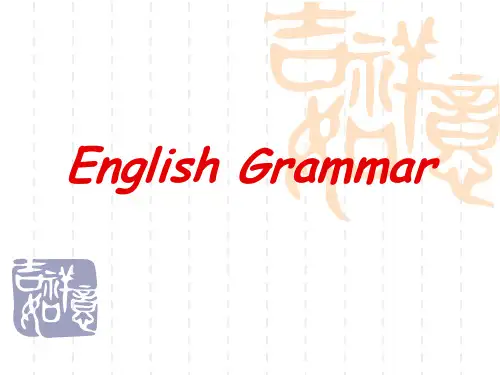
grammatical meaning
a form of verbs indicating the relationship between the Subject and the Predicate
classification
active voice * passive voice:
*
be + p.p. (vt.)
simple sentence
5 basic sentence patterns S. + vi. + … S. + V. + P. * S. + vt. + O. + … * S. + vt. + Oi. + Od. + … * S. + vt. + O. + O.C. + …
transformation
*
*
The boy asked the teacher to explain the sentence.
→The
teacher was asked to explain the sentence by the boy.
We heard them talk about that film. →They were heard to talk about that film. * We heard them talking about ... →They were heard talking about that film.
Usage of aux. v. 1. to form negative V. I don’t like your hat. 2. to form a question Do you like my hat?
学英语动词知识点总结
学英语动词知识点总结一、动词的定义与分类1. 动词的定义动词是表示动作、状态或行为发生的词语,是英语句子中最重要的词类之一。
2. 动词的分类英语动词可以分为不及物动词和及物动词两大类,又可以分为实义动词和助动词两类。
(1)不及物动词(Intransitive Verb)不及物动词是指后面不跟宾语的动词。
例如:run, swim, sleep等。
(2)及物动词(Transitive Verb)及物动词是指后面需要跟宾语的动词。
例如:eat, write, read等。
(3)实义动词(Main Verb)实义动词是指具有实际意义的动词,可以独立构成谓语的动词。
例如:play, study, work 等。
(4)助动词(Auxiliary Verb)助动词是一种辅助其他动词构成谓语的动词。
例如:be, do, have等。
3. 动词的时态和语态动词的时态有一般现在时、一般过去时、一般将来时等。
动词的语态有主动语态和被动语态两种。
(1)一般现在时(Simple Present Tense)表示现在经常性、习惯性的动作或状态。
例如:I go to school every day.(2)一般过去时(Simple Past Tense)表示过去某个时间所发生的动作或状态。
例如:He watched TV last night.(3)一般将来时(Simple Future Tense)表示将来某个时间或将来经常性、习惯性的动作或状态。
例如:I will go to the park tomorrow.(4)主动语态(Active Voice)表示主语是动作的执行者。
例如:She writes a letter.(5)被动语态(Passive Voice)表示主语是动作的承受者。
例如:The letter is written by her.二、动词的构成1. 动词的词态英语动词有原形、过去式和过去分词三种词态。
大学英语语法术语归纳总结
大学英语语法术语归纳总结在大学英语学习中,语法是一个重要的环节。
掌握英语语法术语对于学习和提高英语水平非常重要。
本文将对大学英语语法术语进行归纳总结,以供参考和学习使用。
一、词类(Parts of Speech)1.名词(Noun)名词用来表示人、事物、地点等的名称。
可分为可数名词和不可数名词。
如:book, apple, love, water等。
2.代词(Pronoun)代词用来替代名词,常用的代词有人称代词、指示代词、不定代词等。
如:he, she, it, this, that, some, any等。
3.动词(Verb)动词用来表示行为、状态或存在等,是一个句子的核心。
可根据时态、语态等变化形式。
如:run, swim, be, have等。
4.形容词(Adjective)形容词用来修饰名词或代词,描述事物的特征。
可用比较级和最高级来进行比较。
如:big, beautiful, tall, happy等。
5.副词(Adverb)副词用来修饰动词、形容词、其他副词等,用于描述行为方式、程度、时间等。
如:quickly, very, soon, often等。
6.介词(Preposition)介词用来表达位置、方向、时间、原因等关系,常与名词或代词搭配使用。
如:in, on, at, for, with等。
7.连词(Conjunction)连词用来连接词语、短语、从句等,使句子结构更加完整。
如:and, but, or, because等。
8.感叹词(Interjection)感叹词用来表达强烈的情感或意见,常用于口语交流中。
如:oh, wow, yes, no等。
二、句子成分(Sentence Elements)1.主语(Subject)主语是一个句子中的核心,通常是一个名词或代词。
如:I, he, the dog, my sister等。
2.谓语(Predicate)谓语是一个句子中的动词或动词短语,用来描述主语的动作或状态。
英语动词总结
英语动词总结英语动词总结动词是英语中最重要的词类之一,它用来描述动作、状态、感受和存在的方式。
根据其用法和功能,动词可以分为多个类别。
本文将总结一些常见的英语动词,并按照其不同的功能进行分类和说明。
1. 动作动词(Action Verbs)这类动词是用来描述人或物体的动作或者活动的。
例如:run (跑)、jump(跳)、eat(吃)、dance(跳舞)等。
2. 状态动词(State Verbs)这类动词是用来描述人或物体的状态或者特征的。
它们不描述具体的动作,而是表达一种状态或持续性的情况。
例如:be (是)、exist(存在)、belong(属于)等。
3. 感受动词(Sense Verbs)这类动词是用来描述人的感官感受或者情感状态的。
它们描述人的感觉、味觉、听觉、视觉、嗅觉等。
例如:hear(听见)、see(看见)、taste(品尝)、touch(触摸)等。
4. 帮助动词(Helping Verbs)这类动词通常与其他动词一起使用,用来表达时态、语气和完成度等。
例如:be(是)、do(做)、have(有)等。
5. 情态动词(Modal Verbs)这类动词用来表达说话者的意图、态度或情态。
它们在语气、可能性、许可性、义务等方面发挥重要作用。
例如:can(能够)、could(可以)、may(可能)、might(也许)等。
6. 不及物动词(Intransitive Verbs)这类动词不需要宾语就能单独使用。
它们描述只有主语而没有宾语的动作或状态。
例如:sleep(睡觉)、run(跑)、arrive (到达)等。
7. 及物动词(Transitive Verbs)这类动词需要宾语来完整表达其含义。
它们描述需要一个接受动作的物体对象的动作。
例如:eat(吃)、open(打开)、throw(扔)等。
8. 及物和不及物动词(Transitive and Intransitive Verbs)这类动词既可以作为不及物动词使用,也可以作为及物动词使用。
英语知识点动词总结
英语知识点动词总结Types of Verbs1. Action Verbs: These verbs express physical or mental actions. For example: run, eat, think, write, etc.2. Linking Verbs: Linking verbs connect the subject of a sentence to the predicate and describe a state or condition. For example: is, am, are, was, were, etc.3. Helping Verbs: Also known as auxiliary verbs, helping verbs are used to form tenses, moods, and voices of other verbs. For example: have, has, had, do, does, did, etc.4. Modal Verbs: Modal verbs express the attitude of the speaker towards the action or state of the main verb. They include can, could, may, might, shall, should, will, would, must, etc. Tenses of VerbsVerbs in English are divided into three primary tenses: past, present, and future. Each tense has four aspects: simple, continuous, perfect, and perfect continuous.1. Simple Tense: This tense is used to express actions that occur at a specific point in time. For example: I work, she sleeps, they play, etc.2. Continuous Tense: This tense is used to express actions that are ongoing or in progress ata particular time. For example: I am working, she is sleeping, they are playing, etc.3. Perfect Tense: This tense is used to express actions that have been completed before a certain point in time. For example: I have worked, she has slept, they have played, etc.4. Perfect Continuous Tense: This tense is used to express actions that started in the past and continue up to the present or a specific point in the past, present, or future. For example: I have been working, she has been sleeping, they have been playing, etc.Usage of VerbsVerbs are used in various ways to convey different meanings and functions in a sentence. Some common usages of verbs include:1. Action: To indicate physical or mental actions.2. State: To describe a state or condition of the subject.3. Change: To indicate a change or transformation.4. Intent: To express intentions or desires.5. Permission: To indicate permission or ability.6. Obligation: To express obligations or necessity.7. Emotion: To convey emotions or feelings.8. Experiences: To talk about past experiences or events.9. Future: To indicate future actions or plans.10. Possession: To express ownership or possession.Irregular VerbsIn English, there are many irregular verbs that do not follow the standard rules for forming past tense and past participle forms. Some of the most common irregular verbs include:1. Be: am/is/are, was/were, been2. Have: have/has, had3. Do: do/does, did4. Go: go/goes, went, gone5. Come: come, came, come6. Eat: eat/eats, ate, eaten7. Give: give, gave, given8. Take: take/takes, took, taken9. See: see, saw, seen10. Make: make/makes, made11. Say: say/says, said12. Think: think/thinks, thought13. Know: know/knows, knew, known14. Run: run/runs, ran, run15. Write: write/writes, wrote, writtenRegular VerbsRegular verbs follow a standard pattern for forming past tense and past participle forms by adding -ed to the base form of the verb. For example:1. Walk: walk/walks, walked2. Play: play/plays, played3. Talk: talk/talks, talked4. Jump: jump/jumps, jumped5. Work: work/works, worked6. Dance: dance/dances, danced7. Cook: cook/cooks, cooked8. Clean: clean/cleans, cleaned9. Study: study/studies, studied10. Open: open/opens, openedPhrasal VerbsPhrasal verbs are combinations of a verb and one or more particles (prepositions, adverbs, or both) that together convey a unique meaning. Some examples of phrasal verbs include:1. Look up: to search for information.2. Take off: to remove something, or to leave the ground (for a plane)3. Put off: to delay or postpone something4. Turn on: to start a machine or device5. Look forward to: to anticipate or expect something with pleasure6. Come across: to find or meet someone or something unexpectedly7. Give up: to stop doing something, or to surrender8. Get along: to have a good relationship with someone9. Set up: to establish or arrange something10. Run out: to deplete or exhaust the supply of somethingVerb AgreementVerbs must agree with their subjects in number and person. This means that the form of the verb changes depending on whether the subject is singular or plural, and whether the subject is first, second, or third person.For example:- He plays the piano. (singular)- They play the piano. (plural)- She is singing. (singular)- We are singing. (plural)In addition to number and person, verbs must also agree with their subjects in tense, voice, and mood to maintain proper agreement in a sentence.In conclusion, verbs are a fundamental part of speech in the English language, and understanding their types, tenses, usage, irregularities, and agreements is essential for effective communication. By mastering the various aspects of verbs, one can improve their writing and speaking skills, as well as their overall understanding of the English language.。
- 1、下载文档前请自行甄别文档内容的完整性,平台不提供额外的编辑、内容补充、找答案等附加服务。
- 2、"仅部分预览"的文档,不可在线预览部分如存在完整性等问题,可反馈申请退款(可完整预览的文档不适用该条件!)。
- 3、如文档侵犯您的权益,请联系客服反馈,我们会尽快为您处理(人工客服工作时间:9:00-18:30)。
一般现在时
the present indefinite the past indefinite
一般过去时
一般将来时 the future indefinite 过去将来时 the past future indefinite
现在进行时 the present continuous 过去进行时 the past continuous 将来进行时 the future continuous 过去将来进行时 the past future continuous
*
He said that he would come back the next day. She said that she would be setting off on the 10 o’clock train. He told them that he would have finished by six o’clock.
*
1 unknown or unnecessary S. His car has been stolen. I was born in 1980. 2 emphasize action taker She is liked by everybody. English is spoken here by us.
虚拟语气 3. for speculation 推测
might, may, could, can, must
情v.+v.原→ 对现在状态或经常动作推测 情v.+be doing → 对此时此刻发生的动作行为推测 情v.+have done/have been doing → 对过去发生的事情进行推测 must的否定推测→can’t / couldn’t
Usage of aux. v. 1. to form negative V. I don’t like your hat. 2. to form a question Do you like my hat?
Usage of aux. v.
3. to form inversion
Never did I expect to see him.
S. + vt. + O. + … →O. + be + v-ed + by + S. S. + vt. +Oi. +Od. +… S. +vt. + O. +O.C. +…
*
We gave her some books. →She was given some books (by us). →Some books were given to her (by us).
短语v. --phrasal verb
auxiliary verb
verb used with notional verbs to show tense, voice, or emphatic mood, and to form a question or negative statement; * meaningless itself; * can’t be used as V. alone
English Grammar
Verbs
classification forms features practice 1 2
实义v. ---notional verb (连)系v. ---link verb 助v. --- auxiliary verb 情态v. ---modal verb
及物v. --- transitive
将来完成进行时
the future perfect continuous
过去将来完成进行时
the past future perfect continuous
*She
says she is a college student ~ she was a college student. ~ she will be a college student.
*
*
The boy asked the teacher to explain the sentence.
→The
teacher was asked to explain the sentence by the boy.
We heard them talk about that film. →They were heard to talk about that film. * We heard them talking about ... →They were heard talking about that film.
☆各种虚拟句
☆表示轻微责备or遗憾
情态v. (not) + have done “本应…(而实际却没…)” “本不该/ave (been) done “过去计划中要做某事,实际上没 做”
区别: “shouldn’t + have done” 表示过去本不该做的事情 实际上却做了 “needn’t + have done” 表示过去本不必做的事情 实际上却做了
He told me that he was born in 1959. My mother told me that my grandfather went to Germany in 1917. * Our teacher said that the earth is round and it goes round the sun.
* Has
he told you when he will leave for Beijing?/left for~ ? * Will you tell me when you finished the work?
* She
told me she was a teacher. He said he was studying French. She explained to me that she had made the mistake chiefly out of carelessness. Betty said that she had been waiting for my call.
can could may might must shall should will would need dare ought to
Usage of modal v.
1. to indicate speaker’s tone and attitude 2. for subjunctive mood
*
*
I’ll be a singer when I grow up . If it is fine tomorrow, we’ll have a basketball match with Class Two.
voice of verbs
grammatical meaning * classification * transformation * application * special structures
verb (vt.) verb (vi.)
不及物v.--- intransitive
谓语v. --predicate verb 非谓语v.--non-predicate verb
规则v. --regular verb 不规则v. --irregular verb
终止性v. --terminative verb 持续性v. --durative verb
They shouldn’t have left so early. You needn’t have bought it. You needn’t have come here yesterday.
principal forms of verbs third-person singular form past form past participle (p.p.) present participle
4. to replace mentioned verb to avoid repetition
Do you like English? Yes, I do.
modal verb
verb used with notional verbs to indicate speaker’s feelings and attitudes, i.e. to express possibility, permission, obligation, etc.
grammatical meaning
a form of verbs indicating the relationship between the Subject and the Predicate
classification
active voice * passive voice:
*
be + p.p. (vt.)
We will make our country richer and stronger. →Our country will be made richer and stronger by us. * We elected him our monitor. →He was elected our monitor by us.
She must be studying in the classroom now. She must have been working then. She may/might have been buying stamps in the post office when you saw her.
simple sentence
